
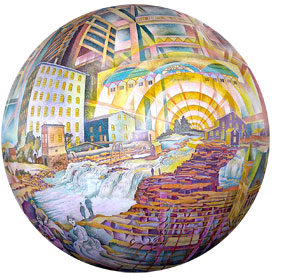 A Round Town
A Round Town
The sphere called A ROUND TOWN painted for the Convention Center in Sioux Falls has been installed!
This new four foot diameter spherical painting called A ROUND TOWN was recently delivered and hung at the Convention Center in Sioux Falls. It was donated to the City of Sioux Falls by Avera McKennen Hospital. I spent six months on this painting.
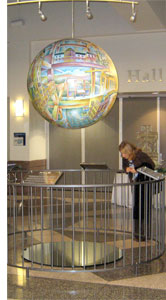 There are historical buildings of Sioux Falls on the bottom of the sphere along with a map of very early Sioux Falls. The grid of the map echoes the Convention Center’s tiled floor. Also in this area is the Falls of Sioux Falls which was the reason why the city was built where it was. The vertical lines of these older building project up into the upper section making the new buildings grow out of the past. The upper part of the sphere holds some of the future Sioux Falls buildings. Above this newer section on the top of the sphere is a cubical grid like the Convention Center’s post and lintel hallway that the sphere hangs in. This cubical structure flows throughout the piece helping to exaggerate the six point perspective used to hold the buildings and the art piece together. The cubical grid also transforms into the sun above the Falls. The rays of the sun expand to create the total Sioux Falls. The upper cubical structure and the lower square tiling both should help the sphere look as if it grew from that architectural spot in which it hangs. The colors play with a cross between pointillism and impressionism. This adds exciting color to look at. The ladies with their umbrellas on the bottom have a feeling of Seurat to them. The colors also have strong contract so the images can be seen from a great distance.
There are historical buildings of Sioux Falls on the bottom of the sphere along with a map of very early Sioux Falls. The grid of the map echoes the Convention Center’s tiled floor. Also in this area is the Falls of Sioux Falls which was the reason why the city was built where it was. The vertical lines of these older building project up into the upper section making the new buildings grow out of the past. The upper part of the sphere holds some of the future Sioux Falls buildings. Above this newer section on the top of the sphere is a cubical grid like the Convention Center’s post and lintel hallway that the sphere hangs in. This cubical structure flows throughout the piece helping to exaggerate the six point perspective used to hold the buildings and the art piece together. The cubical grid also transforms into the sun above the Falls. The rays of the sun expand to create the total Sioux Falls. The upper cubical structure and the lower square tiling both should help the sphere look as if it grew from that architectural spot in which it hangs. The colors play with a cross between pointillism and impressionism. This adds exciting color to look at. The ladies with their umbrellas on the bottom have a feeling of Seurat to them. The colors also have strong contract so the images can be seen from a great distance.
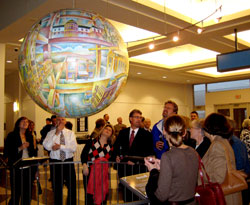 It was wonderful that Avera McKennen commissioned A ROUND TOWN and donated it to the City of Sioux Falls. It is very well displayed. Thanks to Avera McKennen as well as Larry Rehfeld for putting this all together for me.
It was wonderful that Avera McKennen commissioned A ROUND TOWN and donated it to the City of Sioux Falls. It is very well displayed. Thanks to Avera McKennen as well as Larry Rehfeld for putting this all together for me.
New Sphere Just Finished
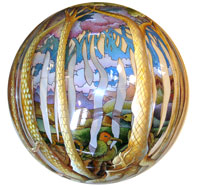
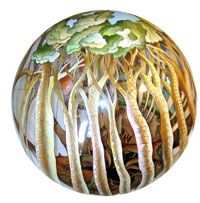 Creatures in the Forest
Creatures in the Forest
Creatures in the Forest is a forest scene that has transparent spaces between the trees. When you look into the sphere you see a landscape with creative animals in it. The foreground is basically vertical lines and the background landscape is horizontal lines. Both are painted in the same space, one is seen on the front while the other is seen on the inside of the same space.
In the Works
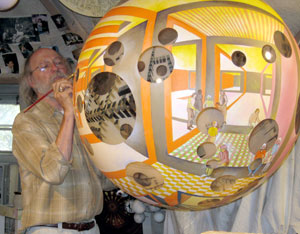 What I am working on at this point is a transparent 36″ diameter sphere. I started with a scene of cubical patterns projecting in six point perspective with a great deal of transparent areas between them. A variety of different size circles where drawn over this. I kept what was inside the circles transparent and painted everything on the outside of the circles with opaque white paint. This white paint now has been turned into a room that these circles (I think of them as spheres) are floating in. People are standing around in the room looking and studying the spheres floating by. The transparent spheres or bubbles have images showing up in them that are coming from the inside of the large sphere. It is interesting that when you look at the small bubbles the image moves across them. When you pull all the images together from all the individual bubbles it makes one total scene. If you get close enough to one of these holes or bubbles you can see the whole inside scene. I am not sure what that means but I think it means something. The transparent spheres do intrigue me. If designed right I can work on the convex as well as the concave sides.
What I am working on at this point is a transparent 36″ diameter sphere. I started with a scene of cubical patterns projecting in six point perspective with a great deal of transparent areas between them. A variety of different size circles where drawn over this. I kept what was inside the circles transparent and painted everything on the outside of the circles with opaque white paint. This white paint now has been turned into a room that these circles (I think of them as spheres) are floating in. People are standing around in the room looking and studying the spheres floating by. The transparent spheres or bubbles have images showing up in them that are coming from the inside of the large sphere. It is interesting that when you look at the small bubbles the image moves across them. When you pull all the images together from all the individual bubbles it makes one total scene. If you get close enough to one of these holes or bubbles you can see the whole inside scene. I am not sure what that means but I think it means something. The transparent spheres do intrigue me. If designed right I can work on the convex as well as the concave sides.
 Matthews Opera House Sphere
Matthews Opera House Sphere
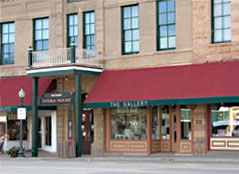 Another spherical painting I am just starting to work on is the MATTHEWS OPERA HOUSE SPHERE. They have commissioned me to paint a 30″ diameter sphere for their stairwell. It is their centennial year +1 of the opening of the Matthews Opera 1906 – 2006. I am just beginning this spherical painting. It will hold the reflection of the Opera as we see it today, the up, down and all around view. I am doing the drawing portion on the sphere at the Opera itself. It is very fun to be able to walk up and study the details right when you need to. Most of my famous interior series are done from the Total Photos I take. Look back at News letter #4 for information on that. This piece will also have historic events that have happened in the Opera woven into it. Paul Higbee of Spearfish is helping me with this history. He is a great historian in relation to the Opera as well as a very good friend.
Another spherical painting I am just starting to work on is the MATTHEWS OPERA HOUSE SPHERE. They have commissioned me to paint a 30″ diameter sphere for their stairwell. It is their centennial year +1 of the opening of the Matthews Opera 1906 – 2006. I am just beginning this spherical painting. It will hold the reflection of the Opera as we see it today, the up, down and all around view. I am doing the drawing portion on the sphere at the Opera itself. It is very fun to be able to walk up and study the details right when you need to. Most of my famous interior series are done from the Total Photos I take. Look back at News letter #4 for information on that. This piece will also have historic events that have happened in the Opera woven into it. Paul Higbee of Spearfish is helping me with this history. He is a great historian in relation to the Opera as well as a very good friend.
I am excited to get to paint this sphere for the Opera House because it has been very much a part of my life. It is extra special to have people from your home town fund your work! I have had one of my Termespheres in the Opera House stairwell for many years now. This new piece will be a little larger. It will be 30″ diameter rather than the 24″.
It will be wonderful to mark 100 years of theatre activities and this incredible symbol for Spearfish with an art piece. I very much want to thank Linda and Bob Meyer for their work in finding the moneys for this painting.
Where Have I Been Lately
The North West Math Conference in Bellevue Washington was a wonderful experience. I was pleased to get to show six Termespheres and get to talk with people about them for three days. I was also one of the keynote speakers for the conference. I enjoyed the other speakers and the displays of books and other items. There were over 1800 math teachers from Washington, Oregon, and British Columbia at this conference.
I am Fascinated by my Connection with Mathematics
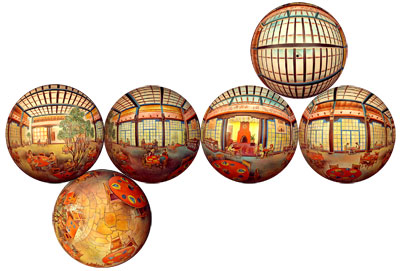 If math is the study of patterns, my work is very much related. When every line one draws is related to the first line you drew, there is some connection to Math. When the realism you draw grows out of a geometry grid, there is some connection.
If math is the study of patterns, my work is very much related. When every line one draws is related to the first line you drew, there is some connection to Math. When the realism you draw grows out of a geometry grid, there is some connection.
When I use the six-point perspective, which is six equal distant points on the sphere, and all lines must always extend to two opposite poles, there is math in this. When every cubical structure I draw must extend to all six equal distant points there is some connection to math. Every cubical line I draw on the sphere is a part of a greater circle.
When the realistic world around you fits into this system of perspective, which all-cubical worlds do, that is mathematics. Many artists find their work fits with other disciplines, my work seems to go over very well with mathematicians.
Does Art HAVE to Be Created on the Flat Surface?
You might think this is a fact when you talk to many artists. Why can’t a painting idea be created in three dimensional space? Why do you have to take six-point perspective back to the flat surface? What if the idea works best in three dimensions?
Just because we would like all things to fit in books doesn’t mean all things have to. You know, we live in a three dimensional world, not the two dimension of the book. I think also many artists wanted to be able to reproduce their ideas for more sales and it is much harder to reproduce in the third dimension. That, maybe could have a lot to do with how they wanted their images to turn out.
When I was at Otis Art Institute in Los Angels I was ask by one of my fellow students, when was I going to “Get serious and get back to the Flat Surface”. I am pretty glad I didn’t get serious.
Why does the Termes Illusion work?
Why does the Termesphere seem to flip and read like it was a concave surface and the motion reverse? My opinion is this: all illusions work because the mind is used to one thing and the designer or artist pushes the image away from that normality. The illusion happens when the mind pushes it back to what it thinks is normal. With the Termesphere, your mind wants to be on the inside of this image to have it be normal. The normal visual world around us is, to our minds, concave. Our minds will push the sphere image, convex, back from the outside of the sphere to the inside, concave. The realism is important for this illusion to happen because we feel like we are more in a normal world with realism. The abstract or geometrically painted spheres can just be that, paint on a sphere. Why is the faster motion important? That is a little harder for me but I think it has to do with you being able to pull the total image together and not think of it as pieces of pictures. When it is all one scene, we know that it is like the world that is always outside of us and we know that scene is on the concave.
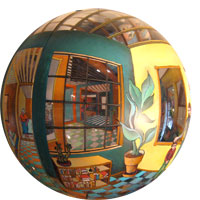 Where Do Ideas Come From?
Where Do Ideas Come From?
I believe most of my ideas come from art pieces I have done in the past. Ideas grow from ideas.
Ideas also come from other artist’s work and from studying geometry of the sphere and also from theories in Science that I read.
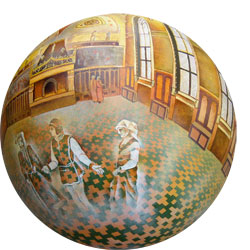 Many building interiors also have inspired my art. I have done a whole series of Famous Interiors of places like Notre Dame, Saint Chappell, St. Denis, Paris Opera in France, Blue Mosque, Hagia Sophia in Istanbul, St. Peters and the Pantheon in Rome, Stone Stonehenge and The Globe Theater in England. The Matthews Opera House that I am now working on is part of this series.
Many building interiors also have inspired my art. I have done a whole series of Famous Interiors of places like Notre Dame, Saint Chappell, St. Denis, Paris Opera in France, Blue Mosque, Hagia Sophia in Istanbul, St. Peters and the Pantheon in Rome, Stone Stonehenge and The Globe Theater in England. The Matthews Opera House that I am now working on is part of this series.
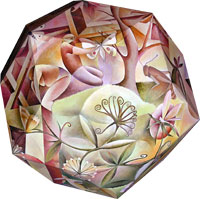 Some of my ideas grow from my subconscious mind. I sometimes paint a loose abstract painting with no image in mind. The patterns and colors stimulate images and ideas. I just have to be brave enough to follow my intuition for these images. It is fun to see what ideas are hidden within my mind.
Some of my ideas grow from my subconscious mind. I sometimes paint a loose abstract painting with no image in mind. The patterns and colors stimulate images and ideas. I just have to be brave enough to follow my intuition for these images. It is fun to see what ideas are hidden within my mind.
Thank you for reading to the end
I hope some of my thoughts will get some comments back from you, positive or negative and new ideas.
I love the way some of my math friends are making suggestions of concepts for me to consider. If you would like to be taken off this newsletter list please let me know. As always, thank you for your tremendous support and encouragement. I would love to hear what you think.
Feel free to call at 888-642-4805 or email me termes@blackhills.com